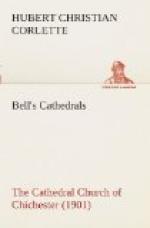Leading out of the south walk is a doorway, through which the deanery may be seen beyond the end of a long walled passage known as S. Richard’s Walk. Looking back northwards, there is a fine view of the spire and transept from the end of this walk.
The chamber over the present singing school between the south arm of the transept and the west walk of the cloister shows the effect produced by some changes made during the fifteenth century. The masonry was more carefully finished than that of the adjoining transept—a specimen of twelfth-century work. The joints in the later work are thinner, and the average size of the stones is in this case smaller.
On the south side of the wall of this chamber are two buttresses. Close under the shallow moulded coping at the top of the wall are two fifteenth-century windows. They are not placed centrally over the others below. In design they are each divided into three lights by mullions. On the east side of the middle buttress is an old rain-water head of (eighteenth-century?) leadwork. Part of the lead piping still remains, having the old ears to fasten it to the walls. The west side of this chamber has one buttress on the south angle and a window in the centre of the wall. Above it is the low slope of a gable. The window is similar to those on the south side, but the head is a pointed and four-centred arch. The mullions have been restored. Below the part just described is the earlier work of the thirteenth century. It rises as far up as to the string-course formed by the continuation of the abaci of the capitals in the two small single-light windows. These narrow and sharp-pointed windows are peculiar. The arch-moulds are different from the other work of the same date in the church. There is no sign of tracery in their design, and the jambs have a simple attached shaft in the outer reveal. The bases to these shafts are earlier than those of the shafts to the south aisle chapel windows, and the edge of the inner member of the window arch is merely cut off with a straight chamber. There is one window, the same as these, hidden in the west walk of the cloister. Beneath the windows just described there are two small single-light openings in each portion of walling on either side of the central buttress. These six windows serve to light the vaulted (sacristy) choir school within.
[Illustration: THE EAST WALK OF THE CLOISTER. S.B. Bolas & Co., photo.]
It has been supposed by some that a chapter-house once existed within the paradise close by the west angle of the transept. The south end of the transept rises on the north side of the cloister garth. At the south-west angle a great part of the twelfth-century masonry in the broad flat buttresses remains. The south-east angle and buttresses are quite different. They are perhaps part of the work done during the thirteenth century, though it is possible that they were introduced when Langton inserted the large south




